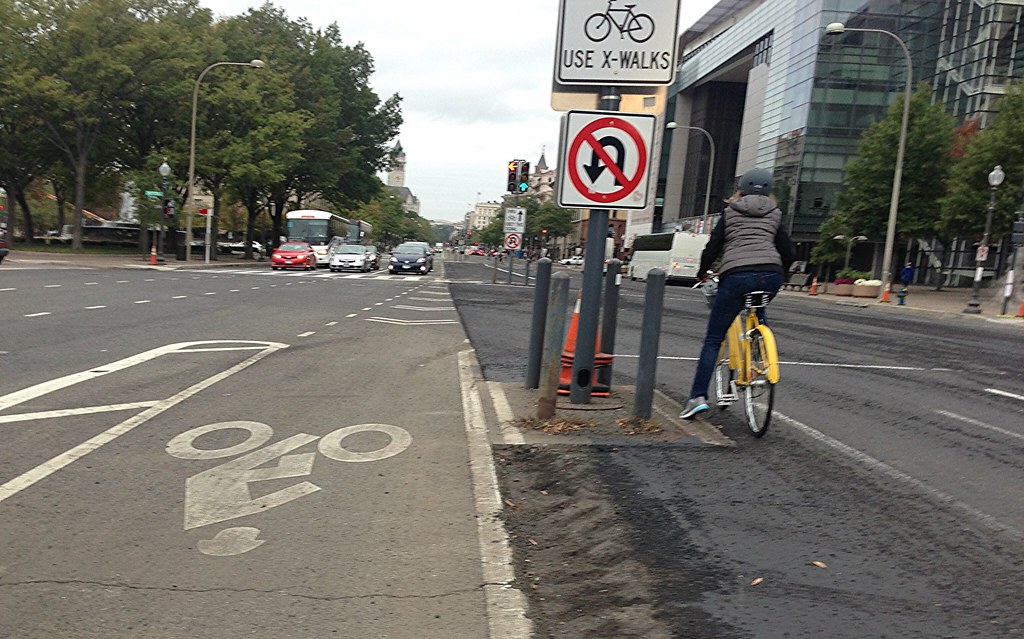 |
| Holey Moley Images by author |
The #BikeDC hashtag on Twitter contains several complaints and concerns from bicyclists regarding the reconstruction of Pennsylvania Avenue, including the following:
these pavement cuts on Penn near 11th-12th are deep, not easy to see, and hazardous. Watch out, #bikedc pic.twitter.com/CaTUEvvcz3— JDAntos (@JDAntos)
There was no coordination between redline safe track and @DDOTDC regarding removal of #bikedc lanes https://t.co/CDDUzyobqd— Paul Angelone (@PaulAngelone)
— Nasty Woman (@nikki_d)
Hey @DDOTDC big gap in pavement EB #PennAve cycletrack at 6 St NW - no warning, seen a few cyclists nearly crash, very dangerous #bikedc pic.twitter.com/NLw2VczkWB— Robert Svercl (@bobco85)
While this work was expected (and perhaps not needed), many things are wrong with the how the District Department of Transportation (DDOT) has managed the milling and repaving of Pennsylvania Avenue, NW so far.
Below is a list of concerns that are troubling given the importance of this corridor for both motorists and bicyclists.
- Notice. Tuesday afternoon, the District Department of Transportation (DDOT) issued a press release. That release stated that construction would begin work between 3rd and 15th and Pennsylvania Avenue, NW - THAT NIGHT. Bicyclists using a major transportation route in the morning would have it removed in the evening. There was no signage along the route warning of the change so cyclists could use an alternative route. DDOT issued no advanced notice to bicycle groups or the media. The following morning, many people still had no idea what happened to their relatively safe route, did not know how long the construction would last or any alternative routes.
If the inauguration repaving continues to the White House, it likely means that the 15th Street protected bike lane will also be repaved and its protective barriers removed. Temporarily. Sill waiting on verification on this potential road work.
- Milling. The process of milling removes the top layers of the pavement and produces a grooved effect. This grooving runs roughly parallel to the travel direction of travel. While it's some what of a nuisance as the street condition reduces cyclists speeds and causes enough vibration to shake parts off of the bike, it's not a particularly bad for bicyclists.
The major problem are the craters and cliffs.
By craters, the process occasionally leaves potholes in areas where they are cracks or voids in the surface or even to the supporting concrete. These potholes can be several inches deep and wide. They can appear at any location and are hard to see at speed, must less so if it becomes a container for rainfall.
The milling process also creates a two or more inch grade separation between the milled street and the remaining brick crosswalks. Experienced cyclists can jump them or move into vehicular travel lanes to avoid them. At other locations, road conditions are so poor that cyclists are forced to ride into oncoming traffic, according to the following statement from JDAntos on Twitter.
Bicyclists have to dodge these problems, in the middle of busy arterial with vehicles moving at speed, without the important pieces of the roadway. This doesn't seem safe.Penn. Ave cycletrack this morning. Cyclists riding into oncoming traffic to avoid deep pavement cuts. #bikedc pic.twitter.com/c9qlLOhaaE— JDAntos (@JDAntos)
Below is a sample of roadway problems along the "protected bike lane":
- Markings. As part of the milling process for Pennsylvania Avenue, the lines and road components that keep order and protect disappear. Temporarily. While most lines reappeared for motorists, they did not for bicyclists. No bike line lines, no protective bollards, no signage, nothing. In certain areas, where motorists heading westbound and make left turns, they received and extra lane - the former protected bike lane.
The areas of most concern are the left at Pennsylvania and Constitution Avenues, NW and at Pennsylvania Avenue and 13th 1/2 Street NW. At Constitution, the prior configuration had two vehicle left turn lanes parallel to the center bike lane controlled by a vehicular signal. Now, the bike lane marking are missing, so vehicles make lefts in it. DDOT states that the flexible posts and other bike lane barriers will not be replaced until after the presidential inauguration.
- Safe Accommodation. This is a law. DDOT must provide a reasonable alternative. According to the DDOT press release, DDOT will maintain safe accommodations for people on bikes during the repaving. The center bicycle lanes will shift to the curb lanes and bicycle traffic will be maintained in both directions. This hasn't happened as of this posting.
Safe accommodation is a basic component of the Bicycle Safety Amendment Act, which is supposed to protect bicyclists and pedestrians from construction that poses a risk. According to the Washington Area Bicyclist Association's comments about the similar safe accommodation question with the 15th and L Street construction project, under the Safe Accommodation regulations, DDOT is required to provide a protected bike lane adjacent to the motor vehicle lane as long as one motor vehicle lane can be maintained in the same direction of travel.
The inauguration is important - bicyclists understand this. However, if an important artery for bicycling is removed, DDOT should go out of its way to provide notice and provide a safe and realistic alternative BEFORE work begins. How do we encourage new bicyclists to use District roadways if they are removed with almost no notice? How can we can ask bicyclists to 'make due' with temporary but horrendous the road conditions?
If the District is serious about Vision Zero and making bicycling a viable alternative for residents and visitors, they must prepare in advance for major street construction and ensure that all road users have a reasonable and safe alternative.






This occurs because the Mayor pays lip service to cyclists in DC. The city council is little better. Running DDOT isn't easy but it seems the current administrator is not up to the task.
ReplyDelete